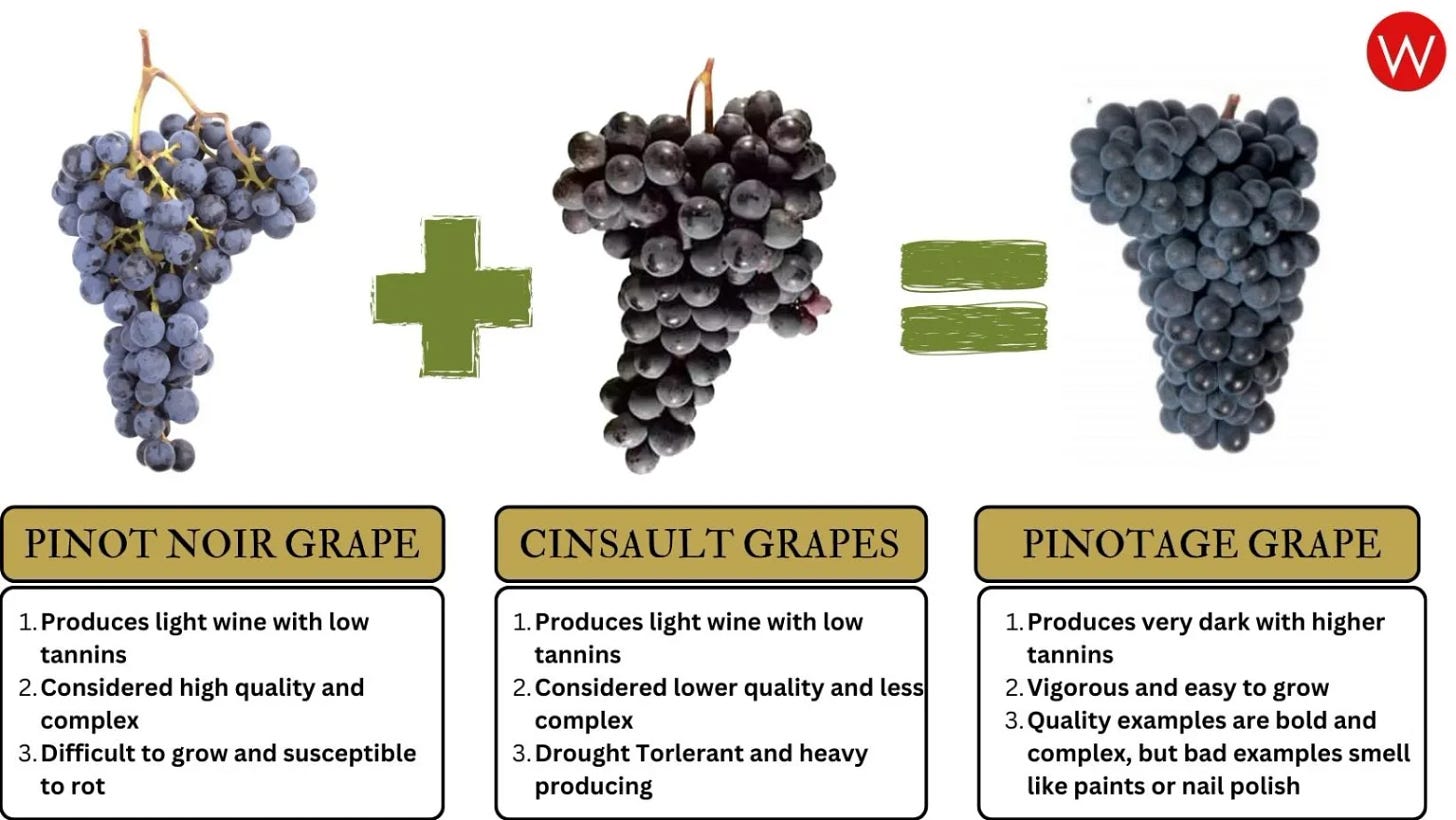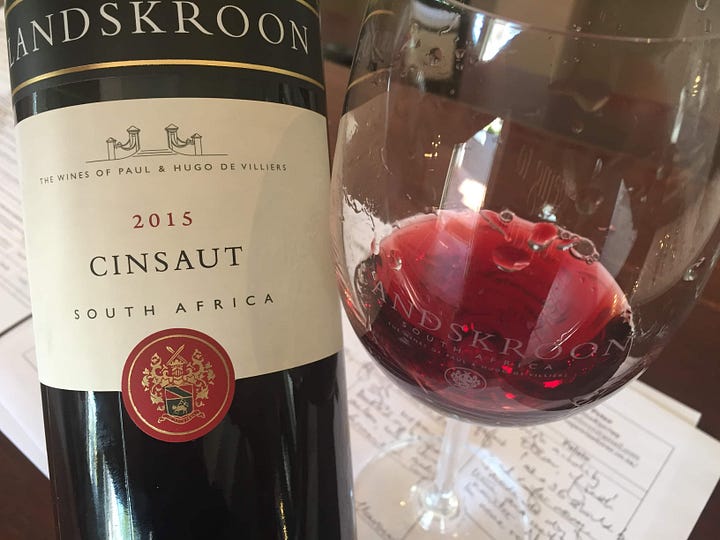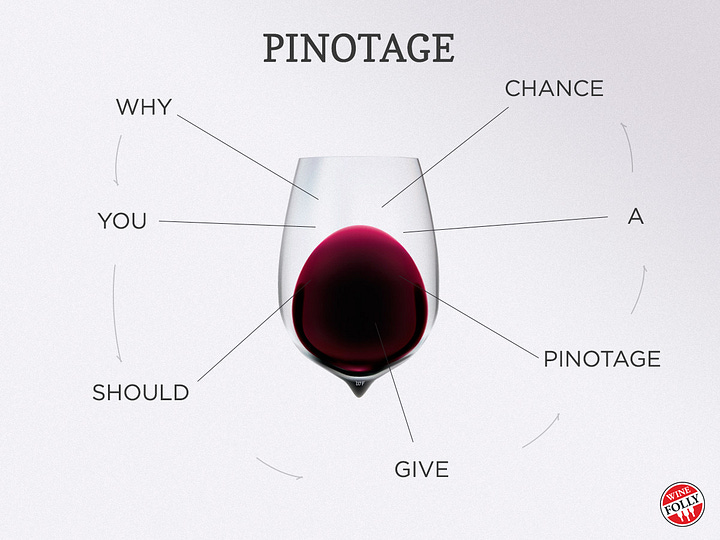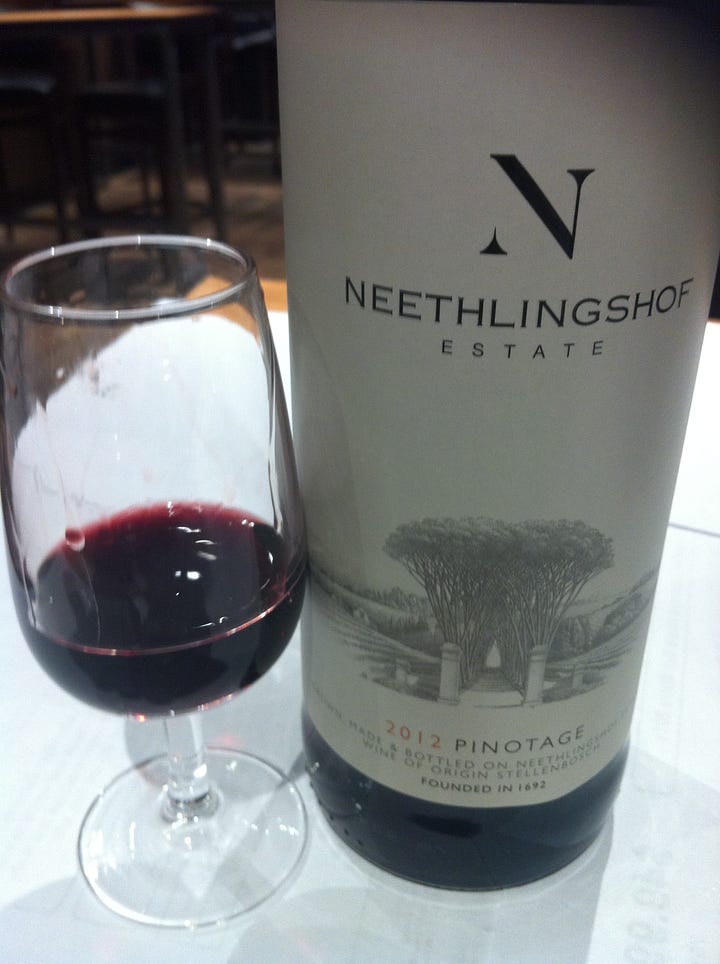Check it Out Now: Funky Soulful Rubber - An Ode to Pinotage
A brief history, and then an 8-bottle tasting to see how this divisive South African grape is faring in the modern moment.
Okay, okay, those aren't actually the lyrics to the song - but quick! Without looking it up, what is the NAME of that song?
Exactly. Let's not pretend to know things here.
And now, let me pretend to know things here:
Pinotage has come a long way since its early days. In 1924 Professor Abraham Izak Perold, Stellenbosch University's first professor of viticulture, experimented with taking Pinot Noir - a grape that did not grow easily in South Africa's hot climate - and give it the hardiness of the grape they called Hermitage (aka Cinsault.) Perold did a little "open-air hybridization" aka he smudged a male Hermitage flower with the pollen from a female Pinot Noir. Thus, the first "Pinotage" (Pinot + Hermitage) was born.

It was Charlie Niehaus, however, a fellow lecturer, who remembered the existence of these experimental plants after Perold left the university for a job at one of South Africa's biggest wine companies, KWV.
Perold was like "oh, hey, money! See ya, higher education!" and never looked back.
Niehaus took it upon himself to graft Perold's plants onto rootstock in proper vineyards and selected which would then become the inaugural mother block of "Pinotage".
But the joke was on all of us: Pinotage exhibits nearly NOTHING of its parents' attributes from a flavor or stylistic standpoint. Pinot Noir and Cinsault are known for their thinner skins and significant acidity, creating elegant, translucent, ruby red wines of light to medium body.


Pinotage is like someone stirred campfire ash into Petite Verdot and double dog dared you to drink it. It's robust, tannic, full bodied, fruit-forward, and staked through with eu de skidded tire.
And folks, it is OH. SO. DELICIOUS.


Pinotage is hands down one of my favorite wine grapes. But it is not the easiest to come by outside of its home country. Especially when the current trend is to poo-poo wines that are dense, jammy, and tannic - the "Parkerized" styles, of which Pinotage often unavoidably is.
Add to this Pinotage's quirky "burnt rubber" characteristic, which is...shall we say, "divisive"?
The more charitable descriptor for this odd flavor note is "smoke" or "campfire", but I have always smelled and tasted it as what critics originally used to denigrate the grape - as "burnt rubber". When it's gentle, I find it tremendous and delectable. When it's allowed to overpower, it's admittedly a bit much.
I've rarely had a Pinotage I didn't like.1 If you think you're not a fan of Pinotage, it's likely that:
You don't like bolder "Parkerized" reds. But look below, because a couple bottles I tried bucked this trend!
You haven't tried a Pinotage that wasn't cheap.
Haven't tried a Pinotage in many, many years.
Just for you lovely people - thinking nothing of myself! (back-of-hand against my brow) - I guzzled tasted 8 bottles of Pinotage. Across a wide range of price points, styles, and even places!
Let's see how they fared.
The 8 Bottles Tasted
Note that I used
’s scoring system (which you can read about here), because it is the most robust I’ve ever encountered. It specifies what I’m taking points off for, so you can know if maybe that’s actually your preferred style or not. And it’s a 100-point system that allows for scores well into the 70’s and 60’s, which is ideal.If I rated a movie 7.5/10, you’d probably take that as a (mostly) positive review. largely worth your time! But if I scored a wine 75/100 on the Parker system, it would mean it was nearly undrinkable. And that’s just dumb.
So note that ALL of these wines are largely worth your time, especially at their price points. Here we go.
Winery of Good Hope Full Berry Pinotage, Stellenbosch, SA ($12)
Now here's something different: "full berry" aka Beaujolais Nouveau style aka carbonic macerated Pinotage! Usually it's the intense, full bodied nature of Pinotage that's considered its selling point. But here we have a lightly colored, lightly macerated, delicate version of the usual.
I taste black cherry, red plum, integrated wet wood flavors, very light tannin, the "rubber" or smoke note is tamed to something more like cola. Similar to a Morgon / meatier style of Beaujolais. Actually, it reminds me of an Oregon Pinot! This is the first time I've ever tasted a Pinotage and noticed any similarity with its Papa Pinot! Well balanced, could surprise those who normally can't stand Pinotage. Held up beautifully Day 1 and 2, was fading by Day 3.
Score Breakdown: Balance 35/40 | Aroma/Flavor 16/20 | Concentration 10/15 | Length 10/15 | Complexity 5/10 = 78 points
Stellar Organics Pinotage 2020, Western Cape, South Africa ($12)
No sulfites added. Oooo, now HERE'S the SMOKE. The lighter side of Pinotage but a bit more intense than the previous. Black cherry, red fruit, black pepper, and solid acidity. Surprisingly low tannins. There's something astringent here, slightly tinny, the burnt rubber veering (skidding?) from the burnt into the *rubber*. It's not an intense flaw, but it's there. I probably dig it more than most, but I have to call it an imbalance.
Score Breakdown: Balance 30/40 / Aroma/Flavor 14/20 / Concentration 11/15 / Length 10/15 / Complexity 6/10 = 70 points
2018 Fleur du Cap "Essence du Cap" Pinotage, Western Cape, South Africa ($15)
Here's the darker (and more expected) side of Pinotage. Dark red fruits bordering on purple. Pepper, spice, and the bottle age has given it a smattering of fresh churned earth. Gorgeous burnt rubber aromas (remember: yum!) undergirding the whole experience.
The alcohol is high (14.5) but doesn't feel it. There's a sweetness on the backend, at least in part due to said alcohol, that compliments the robust qualities but on some sips seemed too sweet. Tannins are smooth as silk.
Score Breakdown: Balance 32/40 | Aroma/Flavor 18/20 | Concentration 13/15 | Length 12/15 | Complexity 7/10 = 82 points
2020 "Taj" Pinotage, W.O. Swartland, South Africa ($17)
Beautifully complex. The nose is earthier, more herbaceous than typical. A phantom aroma of smoke with bramble fruit. Integrated tannins, just the right balance of acidity. You could drink this whole bottle before you knew what you were doing. VALUE BUY OF THE BUNCH.
Score Breakdown: Balance 38/40 | Aroma/Flavor 19/20 | Concentration 12/15 | Length 12/15 | Complexity 9/10 = 90 points
2016 Beaumont Pinotage, Bot River, Walker Bay, South Africa ($25-$35)
Good gravy, this is the kind of heftiness that people who dislike Pinoage complain about! But it's also has 9 years of age on it (but hey, it’s what my wine shop had!) The fruit here is condensed, concentrated like dried fruit. More intense but not as juicy. Notes of earth and tanned leather poking through. There's black pepper and licorice but also brown nut skins, like in a sherry. The alcohol (14%) and sweetness cut through a touch too much. It's a bit too rich. Tasty, but very very.
Score Breakdown: Balance 33/40 | Aroma/Flavor 16/20 | Concentration 13/15 | Length 13/15 | Complexity 8/10 = 83 points
2021 Groot Constantia Estate Pinotage, Cape Town, South Africa ($35)
The youngest of all the Pinotages I tasted, this one is fully red fruit in its flavor, strawberries and red currants, a touch higher acidity than all the others, lending it an uncommon juciness. Cloves and cardamon plus that characteristic anise. At first there was little of my baby burnt rubber, but it soon opened up to unveil a beautifully integrated touch of char.
Score Breakdown: Balance 38/40 | Aroma/Flavor 18/20 | Concentration 13/15 | Length 13/15 | Complexity 9/10 = 91 points
2017 Oak Mountain Winery Pinotage, Temecula, California ($54)
Yes, a California Pinotage! Our one non-South African bottle we could find. Immediately the ripeness comes through on the nose. It's not significantly more alcolhol (14.5%, same as the Fleur du Cap) but feels it. This Pinotage is HOT HOT HOT (as Toyota used to claim.) The burnt rubber is also strong with this one - you'll love it or hate it, but it is prominent. Lovely baking spices and licorice root on the nose.
On the palate, the fruit is dialed back (perhaps with the bottle age) but still an underlying black cherry profile. Followed by pepper, spice, licorice, and surprisingly grippy tannins. On first sip, I thought it overly unbalanced, but every subsequent sip had me enjoying it more. This is a potent, but beautiful Pinotage.
Score Breakdown: Balance 34/40 | Aroma/Flavor 18/20 | Concentration 15/15 | Length 15/15 | Complexity 9/10 = 92 points
2017 L'Avenir Single Block Pinotage (Block 02), Stellenbosch, South Africa ($55)
Wowooowowoowowoowww. Earth, black plum, tar, anise, a field of purple flowers that runs for miles. Dense but stop-and-stare-at-the-glass-in-astonishment smooth; this is layered, dark, and in perfect balance.
The tannins are like fine sand, and a bright hit of acidity to keep it all from being too brooding. Quite possibly the best Pinotage I've ever tried. Words beyond this fail.
Score Breakdown: Balance 40/40 | Aroma/Flavor 20/20 | Concentration 14/15 | Length 13/15 | Complexity 10/10 = 97 points (!)
And there you have it, folks. Go find some Pinotage. Support it, get it out of South Africa and into more import markets, dammit. Papa needs his Pinot. (But not that Pinot, you basic bastards.)
Are you a Pinotage fan? Did you find this screed love letter useful? Tell us in the comments!
That said, the worst wine I've ever tasted was, admittedly, a Pinotage. It was a bottle that sold for $15 USD at Disney World's Lion King area. That's $15 from DISNEY WORLD for a WHOLE BOTTLE. Which should have been a sign. But I had to know!












Just returned from a tasting in Durbanville of eight Pinotages, ranging from a carbonised (very sweet!) pinotage, to a light and enjoyable Method Cap Classique Pinotage, from a lighter style at less than $10, to a heavy and complex $50+ bottle from Bellevue. And with a lovely Pinotage rosé, and a chocolate pairing with a cheap bottle (~$5) in between! Super enjoyable! Such an underrated varietal that deserves more attention 😍
I mean anything from Disney is awful in my very opinionated opinion 🤣 I always like a Pinotage, but maybe drink one every 2-3 years outside tasting at work.